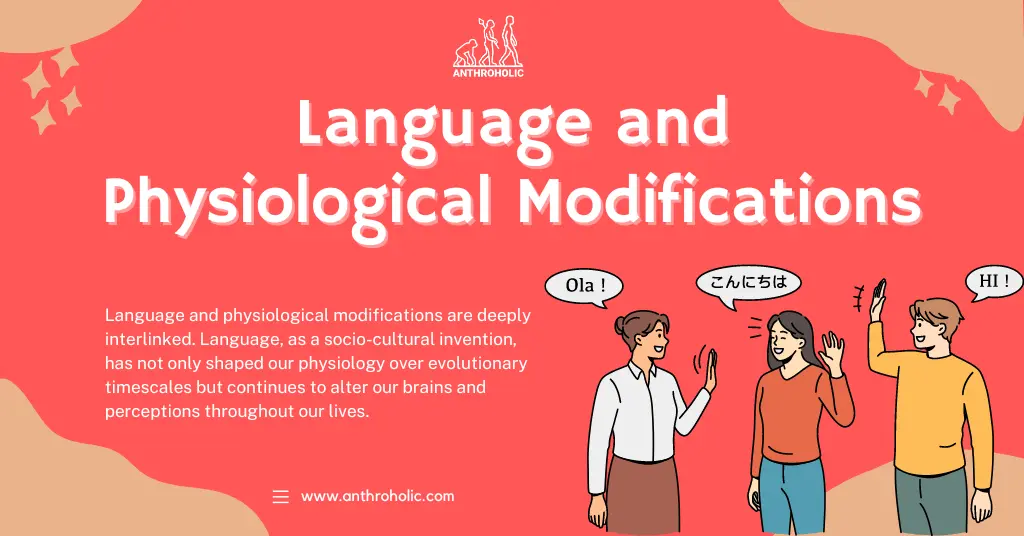AI Answer Evaluation Platform Live Now. Try Free Answer Evaluation Now
Language and Physiological Modifications
Language, a cornerstone of human society, is one of the defining traits of our species. It has evolved over time, adapting to our needs and shaping our cognition. Language is not just a product of cultural evolution, but it is also deeply intertwined with our physiological structure. The purpose of anthropologists in this regard is to dissect the fascinating relationship between language and physiological modifications.

The Physiology of Speech
Understanding the physiological intricacies behind the production of speech is crucial to our discourse. The organs involved in speech production are known as the vocal apparatus, which includes the lungs, vocal folds, oral cavity, nasal cavity, and articulatory muscles.
The Human Vocal Apparatus
Our vocal apparatus has undergone significant evolutionary modifications, making it unique among primates. The lowering of the larynx, the evolution of fine motor control in articulatory muscles, and the expansion of brain regions responsible for language processing are some pivotal physiological modifications.
- Lowered Larynx: The descent of the human larynx provides the pharynx’s length necessary for producing a wide range of vowel sounds [1].
- Fine Motor Control: The evolution of sophisticated control over articulatory muscles aids in the production of complex speech sounds [2].
- Brain Development: Enlarged language-processing areas like Broca’s and Wernicke’s areas are significant for language comprehension and production [3].
| Evolutionary Changes in Human Ancestors | Significance |
|---|---|
| Lowered Larynx | Enables a wide range of vowel sounds |
| Fine Motor Control | Allows for the production of complex speech sounds |
| Brain Development | Facilitates language comprehension and production |
Language and Brain Plasticity
The relationship between language and brain plasticity is a testament to our capacity for physiological adaptation. Studies indicate that the brain’s structure can change as a result of language learning.
Second Language Acquisition and Brain Plasticity
Bilingual or multilingual individuals often exhibit different brain structures compared to monolingual counterparts. Learning a second language, particularly at a young age, can increase the size of language-related brain areas and enhance neural connectivity [4].
Language Loss and Brain Atrophy
Contrarily, language attrition or loss can lead to reduced gray matter in language-related brain regions, highlighting the ‘use-it-or-lose-it’ principle.
The Influence of Language on Perception
Language can also influence our perceptual systems. This linguistic relativity, or the Sapir-Whorf hypothesis, argues that our perception of the world is shaped by the languages we speak.
Color Perception
For instance, speakers of languages with numerous distinct color terms perceive color nuances more distinctly than speakers of languages with fewer color terms.
Spatial Orientation
Similarly, certain indigenous communities, whose languages use absolute cardinal directions for spatial references, exhibit extraordinary orientation skills, demonstrating the interplay between language and cognitive abilities.
Physiological Consequences of Sign Language
Lastly, we must consider sign language users, who rely on visual-manual modes of communication. Long-term use of sign languages can result in enhanced peripheral vision and quicker visual processing times, underlining the plasticity of our perceptual systems.
Conclusion
In essence, language and physiological modifications are deeply interlinked. Language, as a socio-cultural invention, has not only shaped our physiology over evolutionary timescales but continues to alter our brains and perceptions throughout our lives.
References
[1] Fitch, W.T., (2000). The evolution of speech: a comparative review. Trends in cognitive sciences, 4(7), pp.258-267.
[2] Lieberman, P., (2012). Vocal tract anatomy and the neural bases of talking. Journal of Phonetics, 40(4), pp.608-622.
[3] Aboitiz, F., & García, V. R. (1997). The evolutionary origin of the language areas in the human brain. A neuroanatomical perspective. Brain Research Reviews, 25(3), 381-396.
[4] Li, P., Legault, J., & Litcofsky, K. A. (2014). Neuroplasticity as a function of second language learning: anatomical changes in the human brain. Cortex, 58, 301-324.




